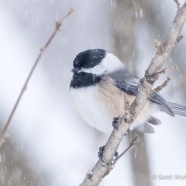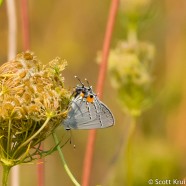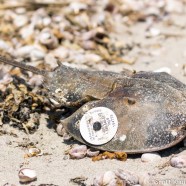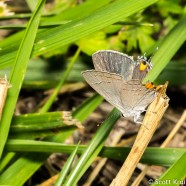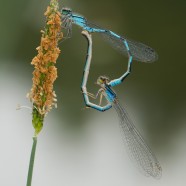Black-capped Chickadee
This may be the last look at a seasonal Sunday bird with snow this winter as it is now meteorological spring! Now that we have crossed into March, cavity-nesting birds like this Black-capped Chickadee (Poecile atricapillus) will be looking for nesting sites. If you enjoy hosting wild birds by providing nest boxes, now is the time to get them ready. Have you ever put out dog fur for birds to use as nesting material? Chickadees, and other small songbirds that use nest boxes and cavities like the Tufted Titmouse, will take fur that you put out in say, an empty suet cage, and use it to line...
Read MoreLate Gray Hairstreak
This is a fresh looking Gray Hairstreak (Strymon melinus) for early September, likely having emerged recently. You would think it is the middle of the summer considering the extremely hot temperatures as of late. Are you seeing new or additional butterflies in the very warm conditions?
Read MoreTagged Horseshoe Crab
I found this deceased Horseshoe Crab at Bridgeport, Connecticut’s Pleasure Beach in June. As you can see it has a large tag on it from the U.S. Fish & Wildlife Service. Here along the Connecticut coast Sacred Heart University is studying the Horseshoe Crab through Project Limulus. This effort monitors populations, helps to track individuals by tagging, seeks to better understand their biology, and works to aid the spawning process by protecting the species and educating the public. Learn more by visiting their website! I reported this individual, a male, which I was told was first...
Read MoreGray Hairstreak
This looks like a worn Gray Hairstreak (Strymon melinus), a butterfly I found recently laying low in the grass. As we enter August we see more and more tattered and torn insects, those strong survivors who have persevered through a tough flight season to feed and reproduce successfully. Between difficult weather, dangerous predators, competition from similar species and human interference it is always special to see the senior citizens of the bug world living on. Scott Kruitbosch Conservation & Outreach Coordinator
Read MoreFamiliar Bluets
Here we have a pair of Familiar Bluet (Enallagma civile) damselflies in a “wheel”, a male and female joined together for mating. They are perched at a pond in this case but they can also fly this way. The male will likely remain with her until she lays the eggs. We are about to enter the prime flight time for our odonata – get out there to any local bodies of water to see what you can find. We will continue to survey for them across the Northeast to gain a greater knowledge of their distribution and abundance plus the health of our waterways.
Read More



